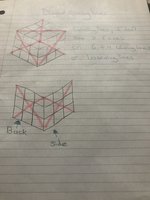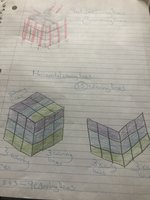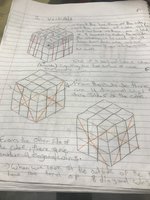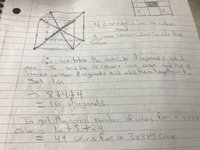Similar to the regular version of tic tac toe you are trying to arrange your marbles into lines of 3. The cube shaped game board is made from 27 transparent unit Cubes arranged in a 3 by 3 by 3 array. How many different winning lines are there in a 3x3x3 cube?
You are using an out of date browser. It may not display this or other websites correctly.
You should upgrade or use an alternative browser.
You should upgrade or use an alternative browser.
Tic tac toe cubed
- Thread starter Teresa
- Start date
Dr.Peterson
Elite Member
- Joined
- Nov 12, 2017
- Messages
- 16,604
Hi, Teresa.
We'd like to work with you. What ideas have you had? What have you tried? Where do you need help?
If you haven't started, you might first find all the possible directions for winning lines, and then count how many of each there are.
Show us any work you can do, and we can work with you. Be sure to read this, which you apparently did not.
We'd like to work with you. What ideas have you had? What have you tried? Where do you need help?
If you haven't started, you might first find all the possible directions for winning lines, and then count how many of each there are.
Show us any work you can do, and we can work with you. Be sure to read this, which you apparently did not.
You are on the right track with your winning diagonal lines. You have worked out there are two for each face of the cube you can see in your two dimensional drawing. But how many faces can you not see? Once you know this, you can work out how many winning diagonal lines there are altogether.
Hint:
To counting winning vertical lines:
Shade in top face of cube. How many squares have you shaded? If each shaded square is the top surface of a vertical line of three cubes how many vertical lines are underneath the top face of the cube?
To count winning horizontal lines:
Shade in right face of cube. How many squares have you shaded? If each shaded square is the right end of a horizontal line of three cubes how many horizontal lines of three cubes form the right face of your cube?
Hint:
To counting winning vertical lines:
Shade in top face of cube. How many squares have you shaded? If each shaded square is the top surface of a vertical line of three cubes how many vertical lines are underneath the top face of the cube?
To count winning horizontal lines:
Shade in right face of cube. How many squares have you shaded? If each shaded square is the right end of a horizontal line of three cubes how many horizontal lines of three cubes form the right face of your cube?
Dr.Peterson
Elite Member
- Joined
- Nov 12, 2017
- Messages
- 16,604
When I count something unfamiliar to me, I feel most confident if I can get the same answer two different ways -- it's easy to miss something!
Along the lines of what hoosie said, one approach is to first pick a direction, and then count how many places there are to start in that direction. For example, vertical lines (going downward) can start anywhere on the top, so the number of spots on the top gives you the count. For horizontal lines, don't forget there are two horizontal directions.
A way to reverse the process, which might make you aware of directions you've missed, is to start not with a direction, but a place. Pick a place (say, a corner of the top) and think about how many directions you could go from there and make three in a row. Some may be subtle! Then you can count how many places in the cube would have the same number of winning rows. (But don't forget that you might be counting the same row twice, once from each end!)
Along the lines of what hoosie said, one approach is to first pick a direction, and then count how many places there are to start in that direction. For example, vertical lines (going downward) can start anywhere on the top, so the number of spots on the top gives you the count. For horizontal lines, don't forget there are two horizontal directions.
A way to reverse the process, which might make you aware of directions you've missed, is to start not with a direction, but a place. Pick a place (say, a corner of the top) and think about how many directions you could go from there and make three in a row. Some may be subtle! Then you can count how many places in the cube would have the same number of winning rows. (But don't forget that you might be counting the same row twice, once from each end!)
Thanks for your help.You are on the right track with your winning diagonal lines. You have worked out there are two for each face of the cube you can see in your two dimensional drawing. But how many faces can you not see? Once you know this, you can work out how many winning diagonal lines there are altogether.
Hint:
To counting winning vertical lines:
Shade in top face of cube. How many squares have you shaded? If each shaded square is the top surface of a vertical line of three cubes how many vertical lines are underneath the top face of the cube?
To count winning horizontal lines:
Shade in right face of cube. How many squares have you shaded? If each shaded square is the right end of a horizontal line of three cubes how many horizontal lines of three cubes form the right face of your cube?
I got 10 winning lines for the diagonal lines, 9 winning lines for verticle lines and 15 for horizontal lines but I’m not sure if it’s correct.
Attachments
Hi there, I am not sure how there are two horizontal lines?When I count something unfamiliar to me, I feel most confident if I can get the same answer two different ways -- it's easy to miss something!
Along the lines of what hoosie said, one approach is to first pick a direction, and then count how many places there are to start in that direction. For example, vertical lines (going downward) can start anywhere on the top, so the number of spots on the top gives you the count. For horizontal lines, don't forget there are two horizontal directions.
A way to reverse the process, which might make you aware of directions you've missed, is to start not with a direction, but a place. Pick a place (say, a corner of the top) and think about how many directions you could go from there and make three in a row. Some may be subtle! Then you can count how many places in the cube would have the same number of winning rows. (But don't forget that you might be counting the same row twice, once from each end!)
Dr.Peterson
Elite Member
- Joined
- Nov 12, 2017
- Messages
- 16,604
Hi there, I am not sure how there are two horizontal lines?
Two directions: left to right, front to back. So, for example, on the top there are 3 one way, and 3 the other.
There are more than that; you've missed some that are not visible on the surface.Thanks for your help.
I got 10 winning lines for the diagonal lines, 9 winning lines for verticle lines and 15 for horizontal lines but I’m not sure if it’s correct.
First, there are 6 faces to the cube, not just the 5 you show; but also diagonal lines can go through the middle, too -- not just on a face.
You're right about vertical lines (one ending at each square on the top); but there are more than 15 horizontal. Keep in mind that they come in two groups as mentioned above.
Then, have you considered lines that cross through the middle from one corner to the other?
Winning lines:
Vertical : White 111,222,333,444,555,666,777,888,999 Total?
As Dr.Peterson suggested consider two directions for each horizontal layer (red and blue).
Horizontal: Red 111,222,333,444,555,666,777,888,999 Total?
Horizontal: Blue 111,222,333,444,555,666,777,888,999 Total?
Diagonals in horizontal plane: White 159,357 for 3 layers. Total?
Also consider winning diagonal lines in oblique planes - Dr. Peterson referred to this in his post.
Using the numbers one of these diagonals is :
1(White top corner)5(Blue centre cube)9(Red bottom corner)
Can you think of the others?
What is your final answer?
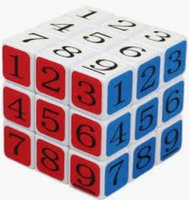
Vertical : White 111,222,333,444,555,666,777,888,999 Total?
As Dr.Peterson suggested consider two directions for each horizontal layer (red and blue).
Horizontal: Red 111,222,333,444,555,666,777,888,999 Total?
Horizontal: Blue 111,222,333,444,555,666,777,888,999 Total?
Diagonals in horizontal plane: White 159,357 for 3 layers. Total?
Also consider winning diagonal lines in oblique planes - Dr. Peterson referred to this in his post.
Using the numbers one of these diagonals is :
1(White top corner)5(Blue centre cube)9(Red bottom corner)
Can you think of the others?
What is your final answer?

For verticals I got 9 because I also counted the middle cube. And for the red diagonals I got 2 and for the blue diagonals I got 2 which adds to 4 so I know that for the other 2 sides I have to add 4 so that’s a total of 8 wins for the diagonals.
Teresa- you correctly counted 4 diagonals for the red and blue faces of the cube and say that you have to add another 4 diagonals for the other 2 sides (faces). But have you missed any faces? A cube has a top face and a bottom face, a front face and a ? face, a left face and a ? face. How many faces does a cube have?For verticals I got 9 because I also counted the middle cube. And for the red diagonals I got 2 and for the blue diagonals I got 2 which adds to 4 so I know that for the other 2 sides I have to add 4 so that’s a total of 8 wins for the diagonals.
You also say there are 8 diagonals inside the cube but I would like you to think about this for a moment- after counting the four diagonals (starting from each of the top four corners through the middle to each of the bottom four corners) you decided to add another 4 diagonals presumably counting those that start from each of the bottom corners through the middle to each of the top corners. But if you turn the cube upside down ( after counting first four diagonals) and repeat the process ( starting from the top face again) are you counting diagonals that have already been counted?
What are your thoughts Teresa?
That’s correct Teresa ( 2 x 9 + 3 x 2 = 24)I got 24 for the three layers for the top middle and bottom
To come up with a formula which will allow us to calculate the number of winning lines for a cube of any size let’s look at how we counted the winning lines for a 3×3×3 cube.
Vertical plane:
9 = 3×3
Horizontal plane:
9 = 3×3 (left to right)
9 = 3×3 (front to back)
6 = 3×2 (diagonals)
Oblique plane(diagonals inside cube)
4
In general if we let n = number of cubes along the edge of a cube of size n×n×n
then we can work out a rule for the number of winning lines of any size cube.
In above example we had 3×9 + 3×2 + 4 = 37 winning lines for 3×3×3 cube.
Using our rule where n = 3 and N = number of winning lines we can write:
N = 3×3² + 3×2 + 4 = 37
General case:
N = 3n² + 2n + 4
What does N equal for a cube of size 4×4×4?
If n = 5 what does N equal?
Try n = 6 and n = 7.
Can you see a pattern?
Vertical plane:
9 = 3×3
Horizontal plane:
9 = 3×3 (left to right)
9 = 3×3 (front to back)
6 = 3×2 (diagonals)
Oblique plane(diagonals inside cube)
4
In general if we let n = number of cubes along the edge of a cube of size n×n×n
then we can work out a rule for the number of winning lines of any size cube.
In above example we had 3×9 + 3×2 + 4 = 37 winning lines for 3×3×3 cube.
Using our rule where n = 3 and N = number of winning lines we can write:
N = 3×3² + 3×2 + 4 = 37
General case:
N = 3n² + 2n + 4
What does N equal for a cube of size 4×4×4?
If n = 5 what does N equal?
Try n = 6 and n = 7.
Can you see a pattern?


